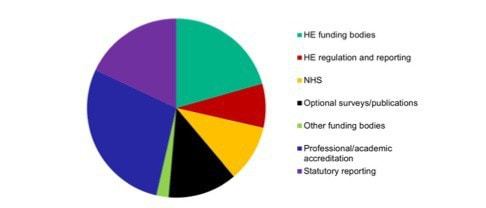Exciting new report on redesigning the higher education data and information landscape
A previous post commented on regulatory issues and the work being undertaken on the “information landscape”. A report on part of this work, the imaginatively entitled “Project B” has recently been agreed by the Interim Regulatory Partnership Group. The report sets out a new way forward for the governance of HE data:
The project report was presented to the Interim Regulatory Partnership Group (IRPG) at its meeting on 15 June. The report envisages a new, collective approach to the governance of the data and information landscape in HE, which could be achieved in the medium term.
IRPG accepted the recommendations of the report and agreed that this work should be scoped as a part of the broader programme of activities being taken forward by the Group.
Part of the evidence considered by the Group was a survey which aimed to establish the totality of external reporting undertaken by HEIs in the UK. The survey identified 550 (550!) separate external reporting requirements and grouped them into seven main categories as follows:

The main recommendation contained in the report is that the key players should get together and agree what data and information is required:
To achieve this IRPG should task some of the key stakeholders in information flows (e.g. HESA, QAA, SLC, UCAS, AoC, Guild HE and UUK) to develop and propose the structure, resourcing and operation of a governance model for the data and information landscape.
This would enable a programme of work, using shared expertise, to create a more coherent set of arrangements for the collection, sharing and dissemination of data. These arrangements would include the identification, development and adoption of data and information standards and the review and scrutiny of data requests.
In order to fulfil this role there would need to be a series of enabling projects, including:
- Develop a calendar and inventory of data collections across the year as a first step towards streamlining collections and improving the timeliness of information
- Develop a data model, lexicon and thesaurus for the sector – this would be a purely administrative/reporting model that does not seek to impinge on academic practice or to impact the way business processes are carried out. It may be that this would be a series of linked models using a consistent approach and a common data language.The establishment of this collective oversight of the information landscape would require each of the organisations involved to make a real commitment to work collaboratively and openly on issues involving data and information.
Whilst these steps will be important they do seem relatively modest aims in the light of the sheer scale of the regulatory burden identified by the group. It remains to be seen how much benefit will result from the establishment of a “coherent set of arrangements” in the medium term. Let’s hope it leads to some real reductions in the data information demands placed on universities.










